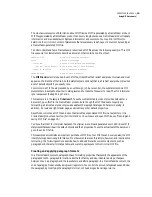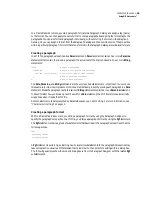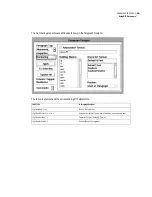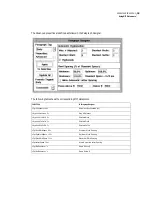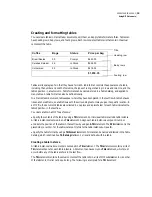
27
ADOBE FRAMEMAKER 6.0
Using MIF Statements
<MIFFile 6.00> # Hand generated
<PgfCatalog
<Pgf
<PgfTag `1Heading'>
<PgfUseNextTag Yes >
<PgfNextTag `Body'>
<PgfAlignment Left >
<PgfFIndent
0.0">
<PgfLIndent
0.0">
<PgfRIndent
0.0">
...
> # end of Pgf
> # end of PgfCatalog
If you open
pgfcat.mif
in a FrameMaker product, you’ll see that the Paragraph Catalog contains a single
paragraph format called 1Heading. If you supply a Paragraph Catalog, the paragraph formats in your
catalog replace those in the default catalog; they do not supplement the default formats.
If you do not supply a Paragraph Catalog in a MIF file, the MIF interpreter provides a default Paragraph
Catalog with predefined paragraph formats.
If a
Pgf
statement provides only the name of a paragraph format, the MIF interpreter supplies default
values for the rest of the paragraph properties when it reads in the MIF file.
Applying a paragraph format
To apply a format from the Paragraph Catalog to a paragraph, use the
PgfTag
statement to include the
format tag name within the
Para
statement. For example, to apply the previously defined format 1Heading
to a paragraph, use the following statements:
<Para
<PgfTag `1Heading'>
<ParaLine
<String `This line has the format called 1Heading.'>
> # end of ParaLine
> # end of Para
To apply a format from the Paragraph Catalog and then locally override some properties, use a partial
Pgf
statement within the
Para
statement. The following MIF example applies the paragraph format 1Heading,
then changes the alignment:
Summary of Contents for FRAMEMAKER 6.0
Page 1: ...MIF Reference Online Manual FrameMaker 6 0 Adobe ...
Page 15: ...15 ADOBE FRAMEMAKER 6 0 Introduction ...
Page 159: ...159 ADOBE FRAMEMAKER 6 0 MIF Book File Statements ...
Page 232: ...232 ADOBE FRAMEMAKER 6 0 MIF Asian Text Processing Statements ...
Page 252: ...252 ADOBE FRAMEMAKER 6 0 Examples ...







